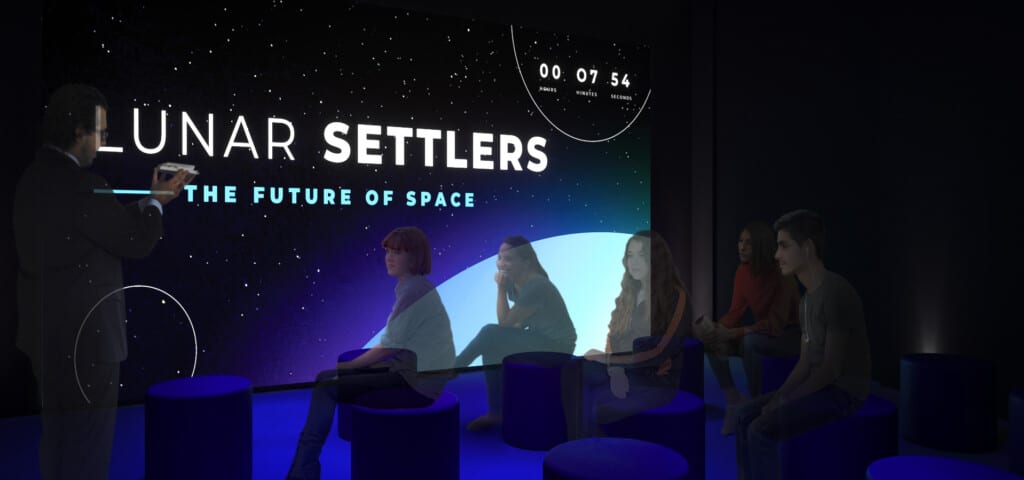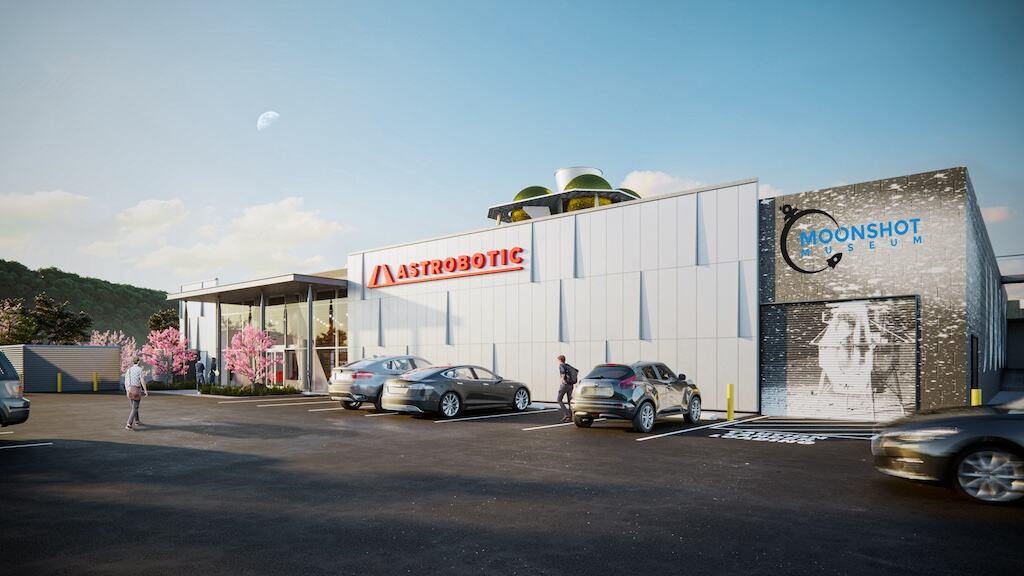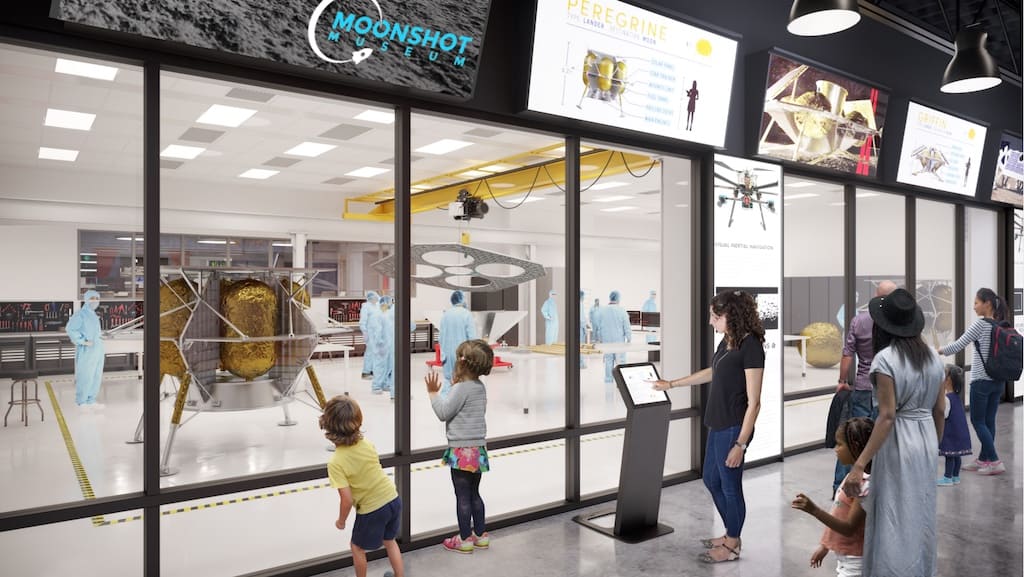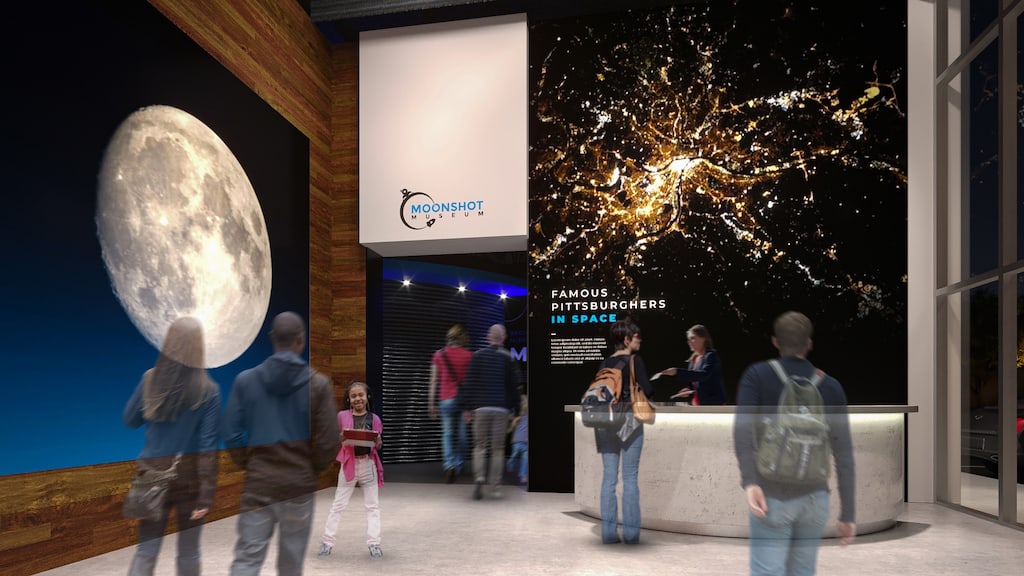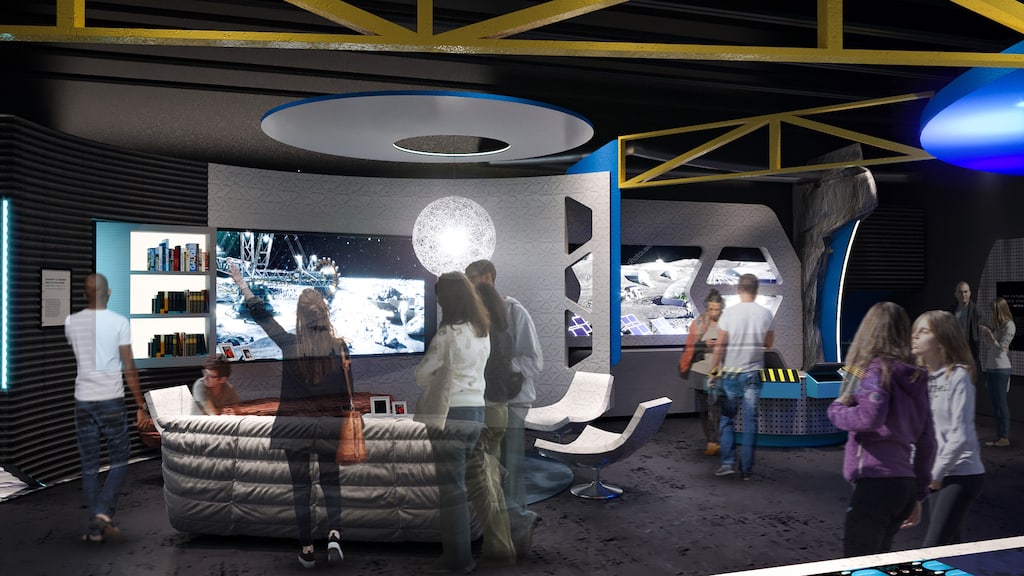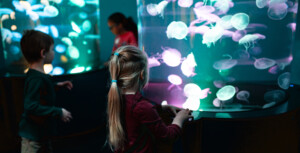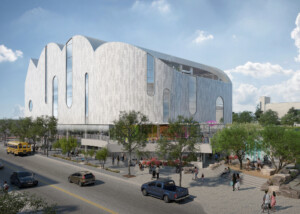The Moonshot Museum is scheduled to open in Pittsburgh’s Northside on Saturday 15 October 2022. Focusing exclusively on space exploration, this new museum will afford visitors unprecedented access to real spacecraft and space industry professionals.
Built on a unique partnership with space robotics company Astrobotic, Moonshot Museum is co-located at Astrobotic Technology’s headquarters. Here, it will offer a window into the construction of real lunar spacecraft. A groundbreaking “living lab” focused on space career readiness, Moonshot Museum has a mission centred on inspiring young people to find their place in the future of space exploration.
A unique project
Sam Moore, the museum’s founding executive director, spoke to blooloop.
Moore has held programmatic and operational leadership roles at a number of respected museums and cultural nonprofits. This includes the National Aviary, the Senator John Heinz History Center, the Missouri Historical Society, and St. Louis’s Campbell House Museum. He is also a past member of the graduate faculty in museum studies at the University of Missouri-St. Louis.
Moore serves on the leadership team for the Public Relations & Marketing Professional Network of the American Alliance of Museums (AAM) and is a past member of the Creativity & Experimentation Task Force for the American Association for State and Local History (AASLH) and AAM’s National Program Committee.
“We are doing something pretty unusual and unique here. It’s been a lot of fun to work on,” he says: “It’s been a wild ride and an exciting journey.”
Future of space travel requires a wide range of disciplines
Moore has always been fascinated by museums:
“They have been the place I have always wanted to go to on vacation since I was eight years old. I’m in my thirties, and it’s still the case. I love storytelling; I love listening to great storytellers. And I love an opportunity to learn about things that I don’t encounter in my everyday life or to learn more about the things I do encounter. I feel museums do a terrific job of that.”
He has worked in the sector for just over a decade. He says:
“I started at a historic house museum in St. Louis, Missouri, where I’m from. My background is in history museums, mostly. Although, I worked at the National Aviary most recently, which is a bird zoo rather than a history museum, which was interesting.
“Space, science and technology are not in my background. However, one of the exciting things we talk about at Moonshot is the fact there really is a place for everyone in the space industry and in space exploration.
“That includes folks like me. People who have a background in the arts and humanities, and who you definitely don’t want building a spacecraft or doing the math that’s involved, but who can talk about the work. People who can design for the future of space, and write for the future of space. You need people and policymakers in space.”
Moonshot Museum’s mission
These are some of the stories the Moonshot project will tell, he explains:
“My journey has been an interesting mirror of what our mission is at Moonshot Museum, which is to make connections for kids and for our community, regardless of what their interests are and regardless of what their backgrounds are.”
Outlining the project’s beginnings, he adds:
“The museum grew out of a company here in Pittsburgh called Astrobotic. This is a company which builds lunar landers and lunar rovers. It is going to return America to the surface of the Moon for the first time in 50 years this year, when the Peregrine Lander lands.”
Over the course of the past three years, Astrobotic has grown from a small company with around 20 employees, to a larger concern with almost 200 employees. In addition, it has secured more than $400 million in NASA and commercial contracts.
“With that growth, they needed a bigger building. In deciding where they were going to put that building, they decided on the north side of Pittsburgh, in the Manchester neighbourhood specifically. They also decided to leave about 3000 square feet at the front of the building free for Moonshot Museum.
“What Moonshot Museum was, exactly, beyond an opportunity for the community to come in and experience the real-time work of the 21st-century space industry, remained to be seen. And that is where I came into the picture.”
Giving the community a front-row seat
Moonshot Museum grew from the notion of giving the local community a front-row seat.
“They spun out a non-profit,” he explains. “I don’t actually work for Astrobotic; I work for a 501(c)(3) nonprofit organisation here in Pittsburgh that just happens to be tightly partnered with a space company – so tightly that we’re in the same building. I’ve got a wall of windows that look into the space where they’re doing their work.”
One question Moore often gets in the context of space and the opportunity that space holds is about the ethics of looking beyond this planet when we have big problems to face here on Earth.
“Between climate change, global hunger, resource and habitat preservation, we’ve got a lot of big issues to solve here. The reality is that space can hold a lot of the answers to those topics. There is no harsher environment that we know of than the surface of the moon. There’s no atmosphere, it’s covered in razor-sharp dust, there’s really intense radiation.”
Lessons from space
By exploring the moon and by spending more time in zero-G, he contends, we can learn how to grow food in harsh environments:
“We can track climate change in a way that is much more effective. The research can provide us with some solutions and next steps on how we can make a change here on Earth. We can also look at space when it comes to the environment and sustainability. The reality is that we have one blue planet to live on. The Moon holds a lot of potential. Mars and the other planets in our solar system hold a lot of potential. But none of them is a replacement for Earth.”
“We are not going to start society anew on another planet. We’ve got this one, and we need to start thinking really seriously about how we’re treating it.”
As an example, he says:
“When we look at strip mining the Earth versus strip mining a barren rock that is orbiting the sun and has more metal in it than humanity has ever mined, looking outward, so that we can sustain what remains here on Earth, at this point, is going to be really important for us.”
Conversations with young people at Moonshot Museum
These are the conversations the Moonshot Museum team is having with middle and high school students:
“Are we littering on the Moon by sending up a Lander and leaving the Lander there? No; we’re pushing science forward so that we can have Landers 15, 20, 25 years from now that have the capabilities to go back and forth. Do we want to mar the surface of the Moon? Let’s assess what preservation looks like on another planetary body, and weigh that against what preservation on the one planet we have here looks like.”
“Those have been the types of fun, dense questions that 12 and 13-year-olds have a lot to say about. There isn’t a clear answer either way.”
Moore is keen to foster such conversations, addressing societal, policy and big-picture issues alongside the engineering and technology conversations.
A different kind of museum
Touching on the factors that differentiate Moonshot from conventional space museums, he says:
“On the one hand, when you visit us, you are also visiting the headquarters of a commercial space company. We’re in the same building. We share a lobby and are located in what is, today, the largest commercial lunar logistics campus in the world. That sets us apart, right off the bat.”
“The other big difference is that a wall of windows within our museum space looks into the clean room assembly area where Astrobotic is building spacecraft. On one side is an active construction zone where I’m building a museum. On the other side, it is a highly controlled, clean room environment with people in bunny suits, assembling the Paragon spacecraft. That’s going to be the backdrop for the work we do all the time.
“The third that makes us different is that we’re going to be a lot less artefact-based than I’m used to in my background in history museums. In history museums, you see incredible things, you read incredible stories about those things, and you move on to the next case.”
An experiential space
At Moonshot Museum, there will be relatively few artefacts on display. Because the museum is predominantly concerned with the present and the future, there aren’t many items to display, Moore points out, beyond the real-time work happening in the clean room next door:
“Our space is going to be very experiential. It will take you on a simulated lunar mission where you encounter real challenges that space industry professionals face every day. You will also encounter career opportunities that exist across the STEAM spectrum of opportunity.”
The museum is a comparatively diminutive 3000 square feet in size. He comments:
“We are not the largest museum in the world by any means. What we have focused on in designing our space is creating an impactful, meaningful experience. One that leaves you with knowledge you didn’t possess before. Whatever your age, it will also offer some tangible next steps you can take to get plugged into what’s happening in space exploration here in Pittsburgh, and in the country.”
Getting hands-on at Moonshot Museum
In terms of interactive elements, he explains:
“We have a few different stations throughout the museum zones. You will make your way through a lab environment designed to look a lot like the clean room on the other side of the glass. Here, you will assemble a lunar rover and watch them operate, digitally, on the surface of the Moon.
“We worked with the engineering team at Astrobotic as well as with some university partners to think through what a good challenge would be. We don’t hand a 12-year-old the challenge of building a lunar rover. But we do hand them a challenge that takes them through the critical thinking process and the trade-offs that engineers have to make when they decide how a rover is powered, what tools it has on board, and how it makes its way across the surface of the Moon.”
There is also a station where visitors can explore the Moon’s surface:
“When you go on a mission experience inside the museum, you’ll choose a site for your futuristic settlement. You will have to take all the elements that make the Moon a challenging place to explore into consideration: exposure to radiation, huge temperature swings; the danger of lunar dust; communications issues, if you’re on the far side of the moon; access to water; ice: all of these different factors.”
Inspiring future decision-makers
Then there is a zone that looks at art and humanities.
“You will be challenged to design a mission patch for your mission. We will present you with some examples of really terrific mission patches throughout history, from Apollo to Astrobotic’s mission patch, to some Artemis mission patches from contemporary space, and say, ‘Look at the symbolism that is packed into this.’
“Once you’ve designed your mission patch, there is a projector system that captures that image from your page. It then projects it onto a large wall at the back of the museum.”
He adds:
“One of my favourite spots is where we fast-forward 50, 60, 70 years into the future, and take you into a futuristic lunar habitat. We invite you to sit on what is essentially a cosmic city council, to answer big questions about the ownership of the Moon. For instance, are we all sharing it? Are we projecting colonialism onto the surface of the Moon? How is this going to work? Middle schoolers have a lot to say about that.
“Then there are questions about who makes the rules of the road; and whether we set up democratic systems on the moon for settlements, or if we follow the military model that we have traditionally followed for space exploration, where a commander is appointed. All these questions are largely hypothetical right now. Yet, they will become entirely practical during the lifetimes of the kids who are visiting us at Moonshot Museum. These kids might well become space lawyers or policymakers.
“We are going to need policymakers who are familiar with the 21st-century space industry economy. People who can make smart decisions about what comes next.”
Sending messages to the moon
In this zone, visitors will vote on issues. This will create a lunar charter that consists of the decisions their group has made.
“Then, if you’re visiting the museum on a weekend, the station works a little bit differently,” he says. “We will show your votes in the context of the votes of other visitors. So, you can see how the community visiting Moonshot Museum lands, when it comes to these different conversations.”
Every visitor to Moonshot Museum has the opportunity to send a little piece of themselves up to the surface of the Moon. This is through an initiative called Hope Moonshot, devised in partnership with Penn State University, Moore explains:
“We are going to have a station where you write a message, and draw a picture. We capture a digital image of that message and picture and load it onto an SD card. Then, that SD card hitches a ride on one of the Astrobotic landers up to the surface of the Moon. That data that you have given us is going to live on the surface for a really long time.
The message we are trying to share is, if you can send a little bit of yourself up to the Moon from the north side of Pittsburgh, what can’t you do?”
Designing Moonshot Museum
About the exhibition design and programming, he says:
“What is really exciting about this project for me, as a museum person, is they are one and the same. We have designed an immersive experiential exhibition, primarily fuelled by media and programming, that layers onto the built environment.”
The team have been working with partners both in Chicago and Boston to bring the space to life. This includes Luci Creative in Chicago, a full-service experiential design studio. Solomon Group, an award-winning leader in exhibit fabrication, AV systems integration and live event production, provided the AV system design, procurement and integration for the museum. Meanwhile, Richard Lewis Media Group in Boston worked on the media design and Ravenswood Studio was the exhibit fabricator.
The Luci Creative team prototyped and play-tested the experience with over sixty Pittsburgh-area middle school students, building on the insights that came out of this to make the experience more impactful
“When it comes to exhibition design, the challenge of a 3000 square foot space is how to create something where people want to come back and see us again and again. Of course, there will be a different spacecraft or a different stage of assembly on a spacecraft each time they visit, which is a changing feature. But what we didn’t want to do is build and invest in a space that people come to once a year, and that’s enough.”
A flexible approach
Accordingly, what they have done is to maximise the potential of technology and interactives:
“We have built a space that’s chock full of nimble and flexible technology. There are interactive pieces that can completely change based on the mission that you’re going on,” he explains:
“If you are a group of middle schoolers coming to us on a field trip, when we first open, you’ll go on a mission called ‘Lunar Settlers.’ Your mission objective is to set up the first permanent human settlement on the surface of the Moon. Each challenge you face in those zones I described moves you towards that objective.
“However, the vision for this space is for us to build out a catalogue of these mission experiences. So, that when you come next year, you can go on a mission that does not focus on lunar settlement, but on space industry entrepreneurship. Perhaps you’re going through the same physical environment, but instead of building a rover, maybe you’re building a business model.
“Instead of designing a mission patch, maybe you’re designing a marketing campaign. Instead of finding a space to settle, maybe you’re looking for the landing spot for your company’s first lunar lander. It’s a whole different lens on lunar exploration and the space industry, in the same physical space. We will be using the screens in the interactive pieces in a fundamentally different way.”
Moonshot Museum in the digital space
This means visitors – and teachers – will be able to choose from a catalogue of experiences that align with what is being taught in the classroom, and with the next-generation science standards in Pennsylvania, participating in a different experience each time.
“I love that I have no idea how we’re going to be using this space in the future. I know how we’re using it when we open, and we’ve got a vision for what comes next. But there’s also some creative thinking to be done. We have the flexibility, because of what we’ve built in this space, and because of the technology we’ve chosen, to do something wholly different from what we’re building initially, a few years from now.”
The museum will also extend into the digital space:
“If there’s one thing that we’ve learned during the pandemic, it’s that there could very well be an event that happens in the next year, or two, three years, that forces us to pivot our model of public engagement,” Moore says.
“The reality, too, is that after the pandemic, school districts are not in the same place that they were. So, they don’t necessarily have the same funding or access to resources to get out on field trips. When we think about the programming we do at Moonshot Museum, of course, we want people to be in our space. But the reality of what we’re building is that a lot of it is media based.”
An evolving project
Over time, this is something that will be built into digital experiences:
“We’re already doing a lot of digital outreach programming with schools in our local area. Plus we have also done a lot of summer programme outreach this summer. The vision is to take this model and open it up beyond Pittsburgh. We would love for people to be able to dial in from the UK and jump into an experience here. How exactly we do that remains to be seen.”
In terms of how the museum space will evolve over the next years, he adds:
“We have built the space to be relevant 5, 6, 7 years from now. Certainly, building our virtual programme portfolio and our digital outreach portfolio goes hand in hand with that.”
Moonshot Museum will open to the public on Saturday 15 October. From then, he adds:
“From there on, we’ll be open Wednesday through Sundays, five days a week. We also have a relatively low admission price point: $10 for adults and $5 for kids up to age 17. Our hope is that there are not only cool things to see, but there is no financial barrier to visitation for us as well.
“We’re in the final stretch of installation, and, as with any exhibition project, it’s all very dusty. It’s an exciting point to be in.”
